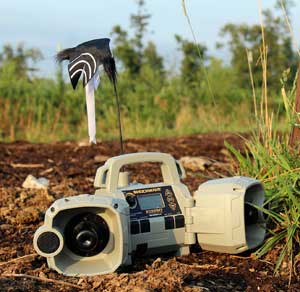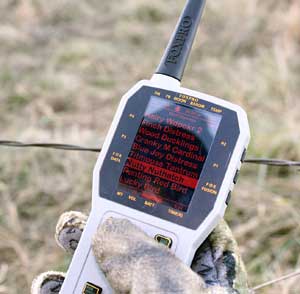Heath Wood | Mossy Oak ProStaff
Abner Druckenmiller of FoxPro harvests coyotes all across North America and throughout the year. He does this by making the most of the many sounds and vocalizations available on his FoxPro electronic caller. Read below to see what different sounds are his favorite and how he does it year after year.
While traditionally, coyote mouth calls have been the go-to way to attract these predators to your location, with today’s technological advances in electronic callers, hunters have access to hundreds of sounds and vocalizations when it comes to trying to fool the most educated coyotes. Some of the most asked questions of beginning coyote hunters include:
- Other than coyotes howling, what are all of the other sounds used for?
- What are the best sounds to use when coyote hunting?
- Should different sounds be used in the spring and summer as opposed to fall and winter?
Even though many hunters have used coyote vocalizations in their calling sequence for years, it seems that over the last decade, the popularity of incorporating coyote vocals and decoys into every setup has intrigued many beginning hunters as well as the seasoned hunters who need a little spice added to their calling.
One of the most popular techniques when using vocals is to start off a stand with some coyote howls, wait a few minutes and then begin playing distress sounds. A simple rabbit distress call seems to still be the go-to sound above any other.
Understanding Coyote Behavior
Learning about coyote behavior is like unlocking a secret code to the wild. These clever canines are known for their adaptability, but at the heart of their survival skills are some consistent behaviors that can help us get to know them better — especially if you’re looking to call them in.
-
Territoriality
Coyotes are territorial animals. They stake out areas that they consider theirs and fight to keep it that way. This territorial nature is essential to remember because when you’re calling coyotes, mimicking an intruder like a bobcat or another coyote family can sometimes provoke a response. Coyotes, curious and protective, might come to investigate or defend their turf against what they perceive as a potential threat.
-
Social Structure
Social structure plays a big part in their lives, too. Coyotes can live in family units or alone. The sounds they make — howls, yips and barks — are not just random noise. They’re communication. A lone howl can gather the pack, yips can signal play or warn of danger and barks might express alarm. Understanding these vocalizations can affect your strategy when selecting calling sounds. Replicating a coyote's howl, for example, can either draw them in out of curiosity or challenge them.
-
Hunting Instincts
Coyotes are predatory animals at the top of their food chain. This means that the natural response of a coyote to certain sounds, especially those of prey in distress (like rabbits or fawns), can be used to your advantage. These sounds can trigger the coyote’s hunting instincts, leading them directly to you.
By tuning into these aspects of coyote behavior — territoriality, social structure and natural responses — you can choose the ideal combination of sounds when calling them.
 Coyote Calling Tips
Coyote Calling Tips
Co-host of FoxPro Furtakers on the Outdoor Channel, Abner Druckenmiller likes to start his setups with the sound Coyote Pair from his FoxPro electronic caller and then a moment later he will throw in some distress sounds.
“I like to paint a picture when specifically targeting coyotes,” said Druckenmiller.
One of the main reasons for using coyote vocals is to mess with a coyote’s territorial instinct. When using a coyote bark, it fools the predator into thinking that a pack of coyotes has invaded his or her area, which makes them respond.
If not for a territorial reason, coyotes will also respond to coyote vocals trying to beat one another to a free meal. Druckenmiller is not limited to just coyote howls, adding that he uses multiple coyote vocal sounds like Coyote Growls, Coyote Pup Distress 3 and Yipping Coyotes. Some specific sounds are better suited to certain hunting times. For example, Female Coyote Whimpers are ideal for use during breeding season.
Adding realism to game calls is a great way to prevent pressured coyotes from learning the most commonly used sounds by hunters. Although Druckenmiller prefers using coyote vocals to build confidence in stands, using many of the unique sounds on the caller such as bird sounds can also up the success rate of calling in coyotes.
Several years ago, I attended a predator hunting seminar in which the speaker was talking about carrying a crow call with him when calling predators. He touched on the point of making a setup more exciting by adding a few crow sounds into his calling sequence. At first, I was skeptical. However, after hearing this, I begin noticing how many times I would call in crows when targeting coyotes in my own setups. Just like the seminar speaker was saying, all of the commotion of the crow sounds lets animals in the area know that something is going on, enticing them to check it out.
Druckenmiller agrees with this tactic, saying he has used crow sounds and magpies, along with coyote vocalizations, to add realism. The same goes for using prey distress sounds.
“I will start off with Bay Bee Cottontail, then go to something with more volume to reach out further like Eastern Cottontail and Jackrabbit Distress,” said Druckenmiller. “I always play sounds such as Nutty Nuthatch or Ranting Red Birds on my stands. I like to mix up the bird sounds to cast out a different cadence of sound to try to trigger a response.”
After playing his desired calling sequence, Druckenmiller will add some more coyote vocals to end his calling efforts.
“I will play Yipping Coyotes, then towards the end I play Coyote Pup Screams, or Pup Distress 3 for approximately four to five minutes then sit silent or play Vole Squeaks for one more minute before I break stand,” adds Druckenmiller.
As for answering the often asked question as to what all of the other sounds on the caller are used for, they are used to make the common distress sounds work as much as possible. As Druckenmiller says, it is to build confidence for a coyote that everything is real, making him come to the call. The unique sounds being used to add realism is the same as a turkey hunter scratching the leaves with his or her hand when calling to a gobbler. It paints a picture in the animal's head assuring them that everything is good.
Calling Coyotes: When to Use Which Calls
 When asked what time of year to use predator calls, some hunters say that they only use vocals during the winter months when coyotes begin breeding. Coyotes are more vocal during that time. However, some of the best coyote hunters that I have talked to over the years have one thing in common: they stick to the same sounds all year long. Druckenmiller is one of those hunters.
When asked what time of year to use predator calls, some hunters say that they only use vocals during the winter months when coyotes begin breeding. Coyotes are more vocal during that time. However, some of the best coyote hunters that I have talked to over the years have one thing in common: they stick to the same sounds all year long. Druckenmiller is one of those hunters.
He said, “My go-to sounds do not vary from year to year or coast to coast.”
Druckenmiller hunts coyotes throughout the year in several different states. By adding coyote vocals, enticing those vocals with bird sounds and adding unique sounds when using distress calls, he is able to successfully harvest several coyotes a year by sticking to the basic distress sounds and making those sounds work by adding a wide variety of sounds along with them.
In my own experience, I too have found that sticking to basic sounds all year can be very successful. This especially goes for using coyote howls. I have had coyotes running into a basic howl during the spring, summer, fall and winter. Making the most of the sound library to juice up basic calls is a surefire way to bring in more coyotes on a regular basis.
Common Mistakes to Avoid
Many hunters are overenthusiastic about using coyote calls for the first time in the field. Avoiding the following mistakes can make the difference between a successful hunt and a learning experience.
-
Overcalling
Overcalling can diminish returns in coyote hunting. Coyotes are cautious by nature and may perceive excessive calling as unnatural or threatening, leading to avoidance rather than attraction. Use calls judiciously by imitating natural wildlife sounds to pique a coyote's curiosity without overwhelming them.
-
Inconsistent Use of Calling Sounds
Inconsistent use of sounds can undermine your efforts in coyote calling. Coyotes have keen ears and can detect when something doesn’t quite match up to the natural order they’re accustomed to. Sticking to a consistent set of sounds that accurately replicate prey or coyote vocalizations helps create a believable scenario, increasing your chances of drawing them in.
-
Ignoring Wind Direction
Ignoring wind direction is a common oversight that can alert coyotes to your presence. These animals have an exceptional sense of smell, and if the wind carries your scent toward them, it can make them cautious and likely to avoid the area. Always position yourself with the wind in your favor to minimize your scent's detection.
Practice Calling for a Successful Coyote Hunt
No matter the caller being used, take time to study the list of sounds and vocalizations and become familiar with the many scenarios that can be applied when out in the field. From your choices, paint a picture of an easy meal that a coyote just can’t pass up. When you establish that go-to sequence of calls and vocalizations, you can be confident it will work anywhere.
For more information on FoxPro calls and/or FoxPro sounds, visit www.gofoxpro.com.


 Coyote Calling Tips
Coyote Calling Tips

























